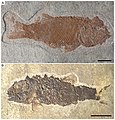깅리모디
Ginglymodi| 깅리모디 시간 범위: Ma | |
|---|---|
 | |
| 얼룩무늬가르(Lepisosteus oculatus) | |
 | |
| 쥐라기 후기 독일산 마크로세미무스페거티(Semionotiformes) | |
| 과학적 분류 | |
| 왕국: | 애니멀리아 |
| 문: | 챠다타 |
| 클래스: | 악티노프테르기 |
| 인트라클래스: | 홀로스테이 |
| Clade: | 깅리모디 코프, 1871년 |
| 서브그룹 | |
깅리모디(Gingingmodi)는 멧돼지과(Lepidotidae)와 그 멸종된 근연종인 멧돼지과(Semionotiformes, Kyphosichthyiformes)와 다른 멸종된 각종 분류군을 포함하는 광지느러미 물고기 분류군이다.깅리모디는 인트라클래스 홀로스테이의 두 개의 주요 하위 그룹 중 하나이며, 다른 하나는 보우핀과 그 화석의 [2][7]친척을 포함하고 있는 할레코몰피이다.

악어가르(Actractosteus 주걱)
| 넵테르기 |
| ||||||||||||
화석 기록
깅리모디안의 화석 기록은 적어도 2억 4천만 년 [8]전 트라이아스기의 아니시안 단계로 거슬러 올라간다.에오세미오노투스는 최초의 글리모디안 중 하나이다.페름기 후기 우키아핑기 시대의 또 다른 분류군인 아센트로포루스와 트라이아스기 초기 파라센트로포루스는 이 그룹의 초기 구성원일 수 있다.깅리모디는 중생대에는 다양했고 널리 퍼져있었지만 오늘날에는 쇠퇴한 혈통을 상징한다.이 그룹은 처음에는 해양 환경에서 진화했지만, 몇몇 계통이 민물 환경으로 [9]별도의 전환을 했다.가장 먼저 알려진 가스는 쥐라기 후기의 것으로 가 화석은 호주와 남극 대륙을 제외한 모든 대륙에서 발견되었다.북미의 [10]담수계에 분포하고 있는 것은 현재 7종뿐입니다.
와이오밍의 에오세 그린리버 형성의 심플렉스(Lepisosteiform Atractosteus simplex)
니제르 백악기 엘라즈 지층에서 나온 피오데테스 니제리엔시스의 비늘
레퍼런스
- ^ Xu, G.; Ma, X.; Wu, F.; Ren, Y. (2019). "A Middle Triassic kyphosichthyiform from Yunnan, China, and phylogenetic reassessment of early ginglymodians". Vertebrata PalAsiatica. 57 (3): 181–204. doi:10.19615/j.cnki.1000-3118.190319.
- ^ a b López-Arbarello, A.; Sferco, E. (2018). "Neopterygian phylogeny: the merger assay". Royal Society Open Science. 5 (3): 172337. Bibcode:2018RSOS....572337L. doi:10.1098/rsos.172337. PMC 5882744. PMID 29657820.
- ^ de Paiva, H. C. L.; Gallo, V. (2018). "Quasimodichthys gen. nov. (Neopterygii: Semionotiformes): A morphological and ontogenetic study". Journal of South American Earth Sciences. 88: 132–143. Bibcode:2018JSAES..88..132P. doi:10.1016/j.jsames.2018.08.010. S2CID 134986658.
- ^ Murray, A. M.; Xing, L.; Divay, J.; Liu, J.; Wang, F. (2015). "A Late Jurassic freshwater fish (Ginglymodi, Lepisosteiformes) from Qijiang, Chongqing, China". Journal of Vertebrate Paleontology. 35 (2): e911187. doi:10.1080/02724634.2014.911187. S2CID 85946657.
- ^ Deesri, U.; Jintasakul, P.; Cavin, L. (2016). "A new Ginglymodi (Actinopterygii, Holostei) from the Late Jurassic–Early Cretaceous of Thailand, with comments on the early diversification of Lepisosteiformes in Southeast Asia". Journal of Vertebrate Paleontology. 36 (6): e1225747. doi:10.1080/02724634.2016.1225747. S2CID 89359438.
- ^ a b López-Arbarello, A. (2012). "Phylogenetic Interrelationships of Ginglymodian Fishes (Actinopterygii: Neopterygii)". PLOS ONE. 7 (7): e39370. Bibcode:2012PLoSO...739370L. doi:10.1371/journal.pone.0039370. PMC 3394768. PMID 22808031.
- ^ Nelson, Joseph, S. (2016). Fishes of the World. John Wiley & Sons, Inc. ISBN 978-1-118-34233-6.
- ^ Romano, Carlo (2021). "A Hiatus Obscures the Early Evolution of Modern Lineages of Bony Fishes". Frontiers in Earth Science. 8: 672. doi:10.3389/feart.2020.618853. ISSN 2296-6463.
- ^ Cavin, Lionel; Deesri, Uthumporn; Olive, Sébastien (2019-07-22). "Scheenstia bernissartensis (Actinopterygii: Ginglymodi) from the Early Cretaceous of Bernissart, Belgium, with an appraisal of ginglymodian evolutionary history". Journal of Systematic Palaeontology. 18 (6): 513–527. doi:10.1080/14772019.2019.1634649. ISSN 1477-2019.
- ^ Paulo M. Brito; Jésus Alvarado-Ortega; François J. Meunier (2017). "Earliest known lepisosteoid extends the range of anatomically modern gars to the Late Jurassic". Scientific Reports. 7 (1): Article number 17830. Bibcode:2017NatSR...717830B. doi:10.1038/s41598-017-17984-w. PMC 5736718. PMID 29259200.










